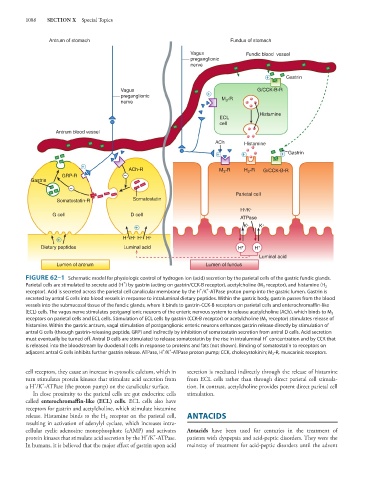Page 1102 - Basic _ Clinical Pharmacology ( PDFDrive )
P. 1102
1088 SECTION X Special Topics
Antrum of stomach Fundus of stomach
Vagus Fundic blood vessel
preganglionic
nerve
+ Gastrin
Vagus G/CCK-B-R
preganglionic + M 3 -R
nerve
Histamine
ECL
cell
Antrum blood vessel
ACh Histamine
+ + + Gastrin
+
ACh-R M 3 -R H 2 -R G/CCK-B-R
GRP-R –
Gastrin
–
Parietal cell
Somatostatin-R Somatostatin
H /K +
+
G cell D cell
ATPase
+ K + K +
+
+
+ H H H + H +
Dietary peptides Luminal acid H + H +
Luminal acid
Lumen of antrum Lumen of fundus
FIGURE 62–1 Schematic model for physiologic control of hydrogen ion (acid) secretion by the parietal cells of the gastric fundic glands.
+
Parietal cells are stimulated to secrete acid (H ) by gastrin (acting on gastrin/CCK-B receptor), acetylcholine (M 3 receptor), and histamine (H 2
+
+
receptor). Acid is secreted across the parietal cell canalicular membrane by the H /K -ATPase proton pump into the gastric lumen. Gastrin is
secreted by antral G cells into blood vessels in response to intraluminal dietary peptides. Within the gastric body, gastrin passes from the blood
vessels into the submucosal tissue of the fundic glands, where it binds to gastrin-CCK-B receptors on parietal cells and enterochromaffin-like
(ECL) cells. The vagus nerve stimulates postganglionic neurons of the enteric nervous system to release acetylcholine (ACh), which binds to M 3
receptors on parietal cells and ECL cells. Stimulation of ECL cells by gastrin (CCK-B receptor) or acetylcholine (M 3 receptor) stimulates release of
histamine. Within the gastric antrum, vagal stimulation of postganglionic enteric neurons enhances gastrin release directly by stimulation of
antral G cells (through gastrin-releasing peptide, GRP) and indirectly by inhibition of somatostatin secretion from antral D cells. Acid secretion
+
must eventually be turned off. Antral D cells are stimulated to release somatostatin by the rise in intraluminal H concentration and by CCK that
is released into the bloodstream by duodenal I cells in response to proteins and fats (not shown). Binding of somatostatin to receptors on
+
+
adjacent antral G cells inhibits further gastrin release. ATPase, H /K -ATPase proton pump; CCK, cholecystokinin; M 3 -R, muscarinic receptors.
cell receptors, they cause an increase in cytosolic calcium, which in secretion is mediated indirectly through the release of histamine
turn stimulates protein kinases that stimulate acid secretion from from ECL cells rather than through direct parietal cell stimula-
+
+
a H /K -ATPase (the proton pump) on the canalicular surface. tion. In contrast, acetylcholine provides potent direct parietal cell
In close proximity to the parietal cells are gut endocrine cells stimulation.
called enterochromaffin-like (ECL) cells. ECL cells also have
receptors for gastrin and acetylcholine, which stimulate histamine
release. Histamine binds to the H receptor on the parietal cell, ANTACIDS
2
resulting in activation of adenylyl cyclase, which increases intra-
cellular cyclic adenosine monophosphate (cAMP) and activates Antacids have been used for centuries in the treatment of
+
+
protein kinases that stimulate acid secretion by the H /K -ATPase. patients with dyspepsia and acid-peptic disorders. They were the
In humans, it is believed that the major effect of gastrin upon acid mainstay of treatment for acid-peptic disorders until the advent

